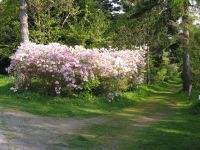royal azalea - Rhododendron_schlippenbachii
English name:
royal azalea
Scientific name:
Rhododendron schlippenbachii
Family:
Ericaceae (heath family)
Height:
up to 3 M in our collection
Flowering:
Late April & early May
Range:
Korea, and nearby areas in Russia and Manchuria
 |
 |
The 48 year old Rhododendron schlippenbachii hedge in the picture is comprised of descendents of plants introduced into Denmark by Aksel Olsen, nurseryman in Kolding. The 16 m long, 2.5 m high, hedge boarders our Lake road soon after the main entrance to the Arboretum.
Plant description:
The genus Rhododendron is one of the worlds largest woody-plant genera and contains many plants of striking beauty. So perhaps I may be excused for featuring a Rhododendron species two months in a row. Rhododendrons can be divided into three groups: First are those with scales on the bottom of their evergreen or deciduous, leaves (lepidotes, in the subgenus Rhododendron). Second are those with evergreen leaves without scales (elepidotes, the subgenus Hymenanthes). Third, are the rest, often referred to as the azaleas, which comprise a diverse group of five or six subgenera. This months plant, Rhododendron schlippenbachii, belongs to the subgenus Pentanthera. This subgenus is characterized by hairy, deciduous, leaves and terminal rather than axial flower heads. There are14 species within the subgenus Pentanthera in the Hørsholm Arboretum.
When in full flower, there is no doubt that R. schlippenbachii is one of the most elegant rhododendrons in the Arboretum. Its striking beauty and its vigour also makes it one of the best azaleas for gardens in Denmark. The rhododendron-specialist and author, Peter Cox, included it in a list over the 12 best Rhododendron species. We have 120 examples of Rhododendron schlippenbachii in our collection. Our oldest living plants came from the Aksel Olsen nursery in 1948 and are seen in a hedge, soon after one enters the main gate (see photograph). We also have 7 different provenances of R. schlippenbachii from the Nordic Arboretum Expedition to Korea in 1976 and a single younger provenance from North Korea. From these can one develop a rather good picture of the variation within this species. However, it would be even better if we also had wild-collected specimens from outside the Korean peninsula.
This is one of the most common shrubs in Korea and often dominates the undergrowth in thin forests. Rhododendron schlippenbachii was discovered by Baron A. von Schlippenbach in 1854. It was first described in 1870 and first introduced into Denmark in 1921.
These are deciduous shrubs often with excellent autumn leaf colours. The inverse egg-shaped leaves occur in whorls at the end of the shoots. The flowers come from the buds which also contain leaves. The flowers are up to 9 cm across, flat-funnel shaped and occur in groups of 3 6. These porcelain-like flowers vary from light to deep pink in colour with darker spots (occasionally pure white forms are found). The seed capsules are covered with glandular hairs and remain on the plant for several years.
This species regenerates easily from seed and is reported not to hybridize with other species, so the seed comes true to type. Unfortunately they grow slowly and typically are 5 to 6 years old before flowering.
References:
Jørgensen, Per M. 2003. Rhododendron i det norske arboret på Milde. 2nd addition, Vigmostad & Bjørke AS, Bergen. 264 pp.
Cox, P.A. 1990. The Larger Rhododendron Species. B.T. Bratsford Ltd. London 389 pp.
Cox, P.A. & Cox, K.N.E. 1997. The Encyclopedia of Rhododendron species. Glendoick Publishing, Perth Scotland. 396 pp.
Davidian, H.H. 1995. The Rhododendron Species. Vol IV. Azaleas. Timber Press Inc. Portland. 184 pp.
Lange, J. 1994. Kulturplanternes Indførselshistorie i Danmark. (Introduction History of Cultivated Plants in Denmark). Jordbrugsforlaget, Frederiksberg. 458 pp.
Wagner, Jeff, 1990. Rhododendron schlippenbachii Maxim. Dansk Rhododendronforenings samlemappe 3.1.5. pp 12-16.
